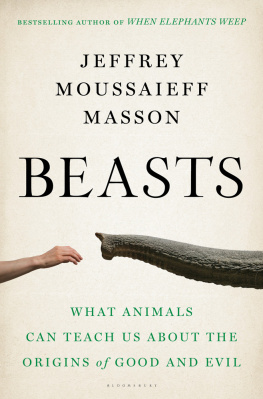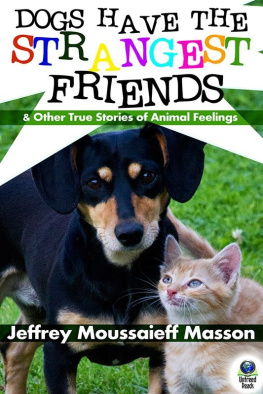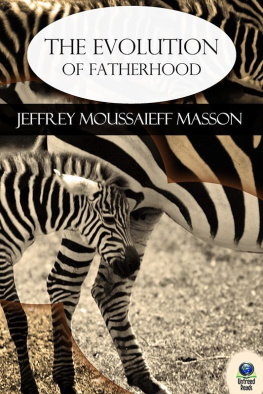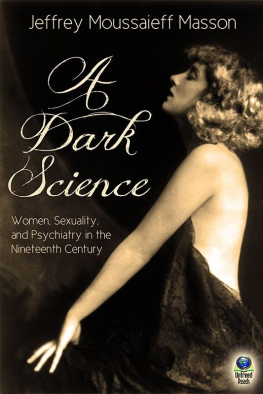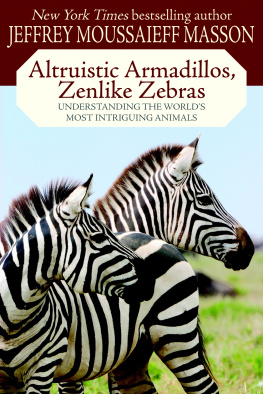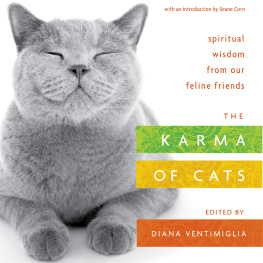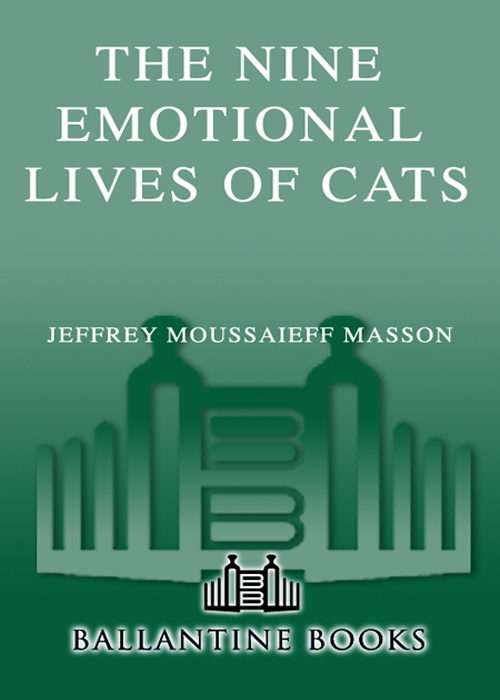
THE
NINE EMOTIONAL LIVES OF CATS
A Journey into the Feline Heart
JEFFREY
MOUSSAIEFF MASSON
BALLANTINE BOOKS
NEW YORK
Contents
For
Leila, Ilan, and Manu,
not to mention
Minna, Miki, Moko, Megalamandira, and Yossie!
Acknowledgments
I could not have written this book without the help of five cats, Minnalouche, Miki, Moko, Megalamandira, and Yossie. The book practically wrote itself; I merely watched them go about their mysterious ways, trying to capture the music of their complex emotional lives.
One human, though, made all the difference. Nancy Miller edited the first book I ever wrote. Actually, Nancy Miller edited most of the twenty books I wrote. We are together again, and I wish I could put her name on the cover. What a treasure; she must have been feline in a former life.
JEFFREY MOUSSAIEFF MASSON
Karaka Bay
Auckland, New Zealand
Summer 2002
Introduction
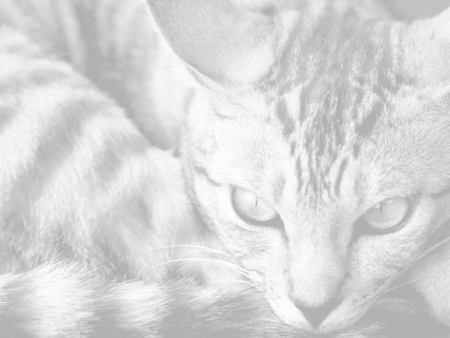
Minnalouche
I have always loved dogs and cats, having lived with both since I was a child. Several years ago I wrote a book, Dogs Never Lie About Love, about the emotional lives of those wonderful animals. It was a very popular book. I noticed, however, that readers of that book would often speak to me disparagingly about catsusually something about cats not really having an emotional life, or cats being basically indifferent. I knew this is not true, though it is untrue in ways that were not always obvious. Too many people tend to see cats as uncomplicated creatures with few emotions, at least none worth thinking about in any depth. I am convinced that, on the contrary, cats are almost pure emotion.
It is impossible to calculate the number of cat books that have been written, but there are something like five thousand currently available. Most of them are pet care manuals; of the rest, some are bad, and a few (some of which are included in my section on recommended reading) are very good indeed. Why one more? Because something is lacking in all the books I have read about cats: a serious consideration of their emotional complexity. It is not that the authors of these cat books doubt that cats have emotions, it is just that nobody has made a concerted effort to delve into their emotional world. The late Roger Caras, who was president of the ASPCA and probably Americas most noted cat expert, remarked that the cat has insinuated itself into human consciousness without revealing any of the secrets about its own feelings. This book attempts to reveal some of those secrets.
Because my wife, Leila, and I had moved from Berkeley to Boston to London over the last few years, we were unable to keep our animals with us. (My dogs are living with my friend and ex-wife, Terri, in Oakland, California; my cats of that time are living on an organic vegetable farm in Occidental, California.) I decided that when we were finally settled somewhere, I would find several cats to live with us and I would try to write about their feelings, as I had with dogs. I was not only curious about cats, I loved cats, loved watching cats, loved spending time with them, and most of all, loved thinking about cats.
The opportunity arose when we moved to New Zealand (because it is a paradise for children and we have two young children). We began building a house on a beach near Auckland, and as I looked around and saw the subtropical rain forest that surrounded the beach, the sparkling turquoise sea, the long path through what looks like a jungle down to the beach where no cars can drive, I thought: This is an ideal place for cats. How would I find them? Of course, no sooner does one think such a thought than cats begin to appear. It is as easy to be found by a cat as it is to find one.
I went first to the SPCA, for it is always a good idea to go to an animal shelter, where cats are waiting for a home. They told me about a woman, Jane, who lived with 120 cats; she had found a particularly appealing stray. Appealing, that is, for affection. When she bent down he reached his front legs up to her and put them around her neck, pushing his head under her chin. Moreover, though large and strong, he did not fight with other cats. He was not afraid of them; he just was not aggressive. This was unusual for a stray cat, and she wondered if he had belonged to somebody. She put up notices, waited, and checked around, but nobody called for him. Maybe he had been on his own for a long time, but he was determined to belong to somebody now. He was so unusually friendly, both with people and with other cats. Would I take him? I said yes, and the very first night, Yossie (as we named him, because our five-year-old son, Ilan, was learning Hebrew and said this was a good Israeli name) slept on my chest. The curious thing is that this was a ploy, or a decision he made in his cunning little feline heart; for after a week, when he knew that he was there to stay, he stopped doing it and has never done it again. Yossie is a bigabout fifteen poundstabby, with green eyes, a long bushy tail, and striking black and brown markings on his back. He was, the vet estimated, just under two when he came to us. His life, I suspect, has not always been easy.
Like many people, I thought of cats as solitary creatures who at best tolerate other cats but are happier on their own (this is why so many people in apartments get one cat rather than twoa mistake, I now believe). Yossie, however, seemed to long for company, and not just ours. Jane took me with her one night on her rounds to feed feral catsthese are cats of whom some are stray, but most were born in the wild, though from domestic parents. Here were animals who could just as easily have wandered off to lead completely solitary lives should they have chosen to do so, yet they lived in cat colonies. The social life of these colonies was complex, if obscure to those on the outside looking in. All of these animals had been trapped, neutered, and released (the kindest thing to do with feral cats, as it ensures that no more homeless kittens will be born in their colony). Some of these cats, because they are all originally domestic (wild cats are a different species of cat altogether), would undoubtedly miss the company of friendly humans and other cats. Because they were neutered, their need for one anothers company had nothing to do with propagating their genes. It must be that cats liked company. I decided, then, that Yossie needed a friend or two, or three, or four.
In theory, I strongly believe cats should be sought rather than bought, rescued rather than bred, since millions of unwanted cats are killed every year in shelters across the United States (except for the few wonderful shelters that have a no-kill policy and let such cats stay on for the rest of their natural lives). La thorie, cest bon (Theory is fine), said the great French neurologist Jean Martin Charcot, but things happen otherwise.
I was visiting a woman who knows a great deal about cats, even if she does breed them, Twink McCabe. Here is one cat where things went a little wrong, she said as she showed Leila, me, and Ilan a little orange-and-white kitten. His ears were too long, his eyes too far apart, his nose too large (as if cats ever cared or even noticed such anthropocentric standards). So Miki (a name to go along with that of his friend at this cattery, Moko) came into our lives. Mikis friend Moko (the name means tattoo in Maori, and he looks as if he were lightly marked with a tattoo), half Burmese and half Siamese, was not a failure, and they were much attached to each other (and still are). Both were three months old. Did it not seem cruel to separate them, rather like adopting one twin from an orphanage and leaving the other to languish, bereft, alone, and brokenhearted? Or so it was put to us. I am not good at resisting the entreaties of a five-year-old or the mewing of kittens. Moko gave the appearance of a ghost-cat, with his pale white wild hair (he is a La Perm) and faint brown stripes going up his long legs. He looked more like a serval or even a lemur than a domestic cat and was as highly strung as a wild animal.
Next page


